Mike Swinford, CEO of Numotion, said in his white paper, Transforming the State of CRT from Within:
For those operating in the industry every day, issue awareness is not the challenge. However, as with all industries, there is need for continuing education at all levels, as well as a need to develop an understanding and appreciation for the full range of activities across the spectrum of the industry. We have a duty to teach one another and conversely an obligation to invest the time to learn from experts. Speed, efficiency and accuracy comes from repetition, but also from how we are taught to do things. For example, if you are not an expert in funding documentation or the latest studies on the benefits of standing, seek help from the experts. Attend a symposium, class or webinar…The reality is that we need to make the time to invest in continuing education and best practice sharing from within and outside of our CRT industry.
There are many opportunities for continuing education in the CRT field. One is the International Seating Symposium (ISS). ISS is a premier annual meeting in the world of clinicians, researchers, manufacturers, suppliers and others who provide seating and mobility to people with disabilities.
It was started in 1982 by members of the Vancouver, British Columbia, Seating Special Interest group. Seating and mobility was in its infancy at that time. Sunny Hill Health Centre for Children, who still organizes the program, took the lead in organizing the first symposium. They brought clinicians, researchers and exhibitors together to develop resources, and create a forum that fostered an exchange of ideas and created a network focused on seating and mobility. This initial meeting in 1983 had 98 participants and 11 exhibitors.
In 1986, Sunny Hill was approached by Doug Hobson (Rehabilitation Engineer from Winnipeg, who was also instrumental in starting RESNA in the late 1970’s) of the University of Tennessee, Memphis Rehabilitation Engineering Program with the proposal of forming a partnership and bringing the ISS to the United States. The 3rd ISS was held in Memphis in 1987. The ISS is now held in Vancouver on the even years and in the USA (First the University of Tennessee, now the University of Pittsburgh, run by Mark Schmeler) on the odd years.
Fast forward to 2018 ISS and the numbers have grown to about 1,500 participants from 27 countries and over 100 exhibits.
In 2019, the ISS will return to Pittsburgh after being held in Nashville for many years. When it is in the US, it has closer to 2,500 participants. They both include huge exhibits, plenary sessions, research papers, posters and instructional courses.
The conference organizers have made a concerted effort to facilitate conferences in other continents as well including European Seating Symposium in Dublin, Ireland, and conferences in New Zealand and South America.
Let’s take a look at some of the highlights from the ISS and ESS this year.
International Seating Symposium, Vancouver, BC - March, 2018 www.seatingsymposium.com
*To view the plenary videos and speaker handouts on this website, go to “Speaker Presentations” from the column on the right *
Lee Ann Hoffman, who is now a Clinical Educator at Numotion, taught a half day on 24-hour postural care with another therapist. She has also published on the subject that contains most of what was presented at the course (
www.NRRTS.org - past issues: Issue 5 of 2017).
Lee Ann will be presenting this information at the Baltimore Nu Fair in September and the Portland and Seattle Nu Fairs in November.
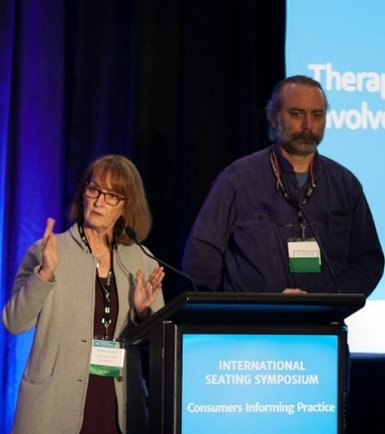
One of the big pushes in our industry now is data and how to use it. We were privileged to have an invitation to do a plenary presentation on this topic, based upon a retrospective study done last year between Numotion and Georgia Tech. This study was the first of its kind in the field. It is published in the
Assistive Technology journal. Additionally, the plenary can be viewed on the ISS website.
There were quite a few presentations on powered mobility evaluation and training strategies for both children and adults. (Lisa Kenyon, Roslyn Livingstone/ Debbie Field, Emma Smith). This has become a hot topic as clinical researchers take a hard and quantifiable look at how we evaluate individuals for power, and how we are or should be training them.
Emma Smith will be presenting at the Portland and Seattle Nu Fairs in November.
There is always an ISS focus on providing CRT in less resourced settings. Rosie Joan Gowran, an OT lecturer at the University of Limerick in Ireland, spoke about a global perspective on wheelchair provision. There is an International Rehab- International Society of Wheelchair Professionals facilitated by Jon Pearlman at University of Pittsburgh. The organization's mission is to “serve as a global resource for wheelchair service standards and provision through advocacy, education, standards, evidence-based practice, innovation and a platform for inf
ormation exchange,” (
www.wheelchairnet.org).
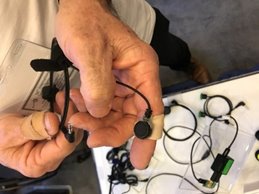 Notes from the ISS Exhibits:
Notes from the ISS Exhibits:
Desmond Wiles, Numotion ATP in Seattle, found Mo-Vis had a new proximity switch that comes in two sizes (1” and ½”), in the Stealth booth for those with very limited movement and strength.
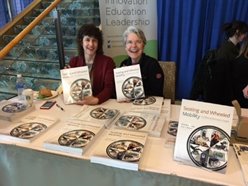
Anne Keischnik, Numotion ATP and Development Manager, supported the book signing of the first seating and mobility text of its kind,
Seating and Wheeled Mobility, A Clinical Resource Guide. Michelle Lange and Jean Minkel not only compiled and edited, but also wrote chapters for this book. A link to purchasing this book can be found
here.
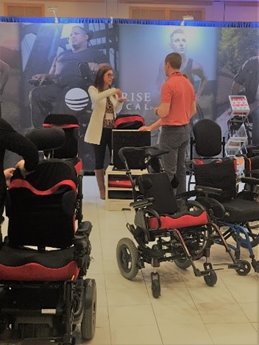
Lee Ann Hoffman, Numotion Clinical Educator, found the Sunrise Spex back support interesting. It has “on the spot” adjustment for clients to address meeting changing needs.
European Seating Symposium, Dublin, Ireland, June, 2018
www.seating.ie
Like the ISS, there are plenary sessions and workshops at ESS.
One of the plenaries was around how seating and mobility has evolved over the years: how advances in clinical practice, technology and product design have led to increasing our ability for functional interventions.
Two therapists, Sharon Sutherland, PT in Ireland, (was in US for many years), and Bar Van Der Heyden, PT in Belgium, both provided a look back to our very clinical, hands-on, but not necessarily evidence –informed, “by the seat of our pants” approach that we used to have. Sutherland stressed that we had lost some of the basics, including a thorough hands-on evaluation, the busier we have become.
Bart suggested that this approach has resulted in poor outcomes. He cited a Danish study from last year which reported that 17 percent of users had no or an incomplete assessment; 23 percent said they have assistive technology they don’t use.
Bart takes a “knowledge is good, strategy is better,” approach. Yes, we have a lot of knowledge but how do we use it and leverage it? We need to ensure that we put more rigor in to the clinical decisions we make: the “intuitive approach” to the evaluation is quicker, but results in more errors. The “analytical approach” requires a bit more time, bit results in fewer errors. We often stress the equipment without critical thinking around the reasons, neglecting to meaningfully include the client in the problem-solving. He used this example:*
Smart:
- X can self-propel 30 meters in 1 min. After the seating intervention, he can self-propel 50 meters in 1 minute.
Smarter:
- X can self-propel 30 meters in 1 min. We can achieve 50 meters in 1 min by adjusting the rear axle 4 cm to the front using a wheelchair seat width which is 3 cm narrower and 2 cm less in depth, a thigh to pelvis angle of 100 degrees and 2 side supports at the lateral rib cage. The products providing this are X and Y.
(*Used with permission. Mr. Van der Heyden can be reached at www.super-seating.com)
Notes from the ESS Exhibits:
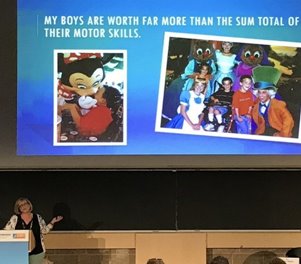
The plenary on experience for mobility interventions and postural management featured Carol Schrader, the (American) mother of triplets, two of whom use mobility devices. They are now adults in their 20’s. She began with life in the NICU and proceeded through her thought processes along the way, from the realization that this was going to be a long-term struggle and from her thoughts about mobility devices through her children’s accomplishments. The only way I can describe this speech is it was a “wake up call” for anyone involved with seating interventions with kids. She provided a raw, unadulterated view on what it’s like on the family side of the seating and mobility team.
Her husband, Wade Schrader, the chief pediatric orthopedic surgeon at Children’s of Mississippi, University of Mississippi Medical Center, also spoke about some of these experiences from his view, in addition to orthopedic surgery-related issues. Carol shares interesting thoughts on her blog,
www.theblessingcounter.blogspot.com.
One of the courses provided a spotlight on staff health, specifically related to individuals who are in direct contact with clients. Paul O’Donaghue, an organizational psychologist and Assistant Professor at the University College Dublin, had a presentation entitled, “Toward Staff Health: a Heuristic (practical) Approach.” He spoke a great deal about burnout and how to avoid it. Two points that really stuck out were to facilitate understanding on all sides, “
clinicians need more organizational training,” and, “
decision-makers and policy makers need more clinical-style training.”
Mr. O’Donaghue has a series of practical articles around management on his LinkedIn site. These can be found at:
https://www.linkedin.com/pulse/outline-coaching-model-paul-o-donoghue. This first article is on coaching models.
To learn more about all of Numotion’s upcoming course and events, please click here.